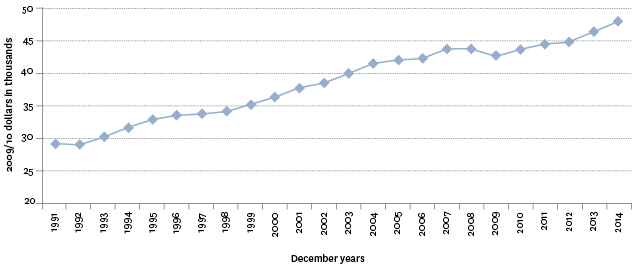Economic standard of living
Market income per person
Definition
The total value of goods and services available to New Zealanders, expressed in inflation-adjusted dollars, per head of population. This is also known as real gross national disposable income (RGNDI) per person.
RelevanceTop
RGNDI per person measures the average income available to New Zealanders. A nation with a rising RGNDI per person will have a greater capacity to deliver a better quality of life and standard of living to its population.
Current level and trendsTop
In the year ended December 2014, RGNDI per person was $47,784 in 2009/2010 dollars. This was $1,467 more than for the year ended December 2013 ($46,317).
From 1992, there was a steady increase in RGNDI per person through to 2007, rising from $29,058 to $43,677. This period of growth was followed by a decline between 2007 and 2009, when RGNDI per person dropped to $42,535, but from 2009 there have again been improvements.
Figure EC1.1 – Real gross national disposable income (RGNDI) per person, 1991–2014

Source: Statistics New Zealand
International comparisonTop
While gross domestic product (GDP) per person is the measure most commonly used to compare income levels between countries, gross national income (GNI) per person more closely corresponds to the measure used in this indicator. To facilitate comparisons, the measure is expressed in United States dollars at current prices and current purchasing power parities. The most complete cross-country comparisons for GNI per person are for 2013.
In 2013, New Zealand GNI per person expressed in US dollars per capita at current prices was below the OECD median ($38,208). It should be emphasised that GNI per person does not tell us anything about how income and other resources are distributed, and should, therefore, be used in conjunction with other measures presented in the Social Report.
Figure EC1.2 – Gross national income (GNI) per person, 2013

Source: OECD
In terms of GDP, New Zealand was ranked 21 out of 33 OECD countries in 2013.
Data for this section can be found at: www.socialreport.msd.govt.nz/documents/2016/ec1.xlsx

